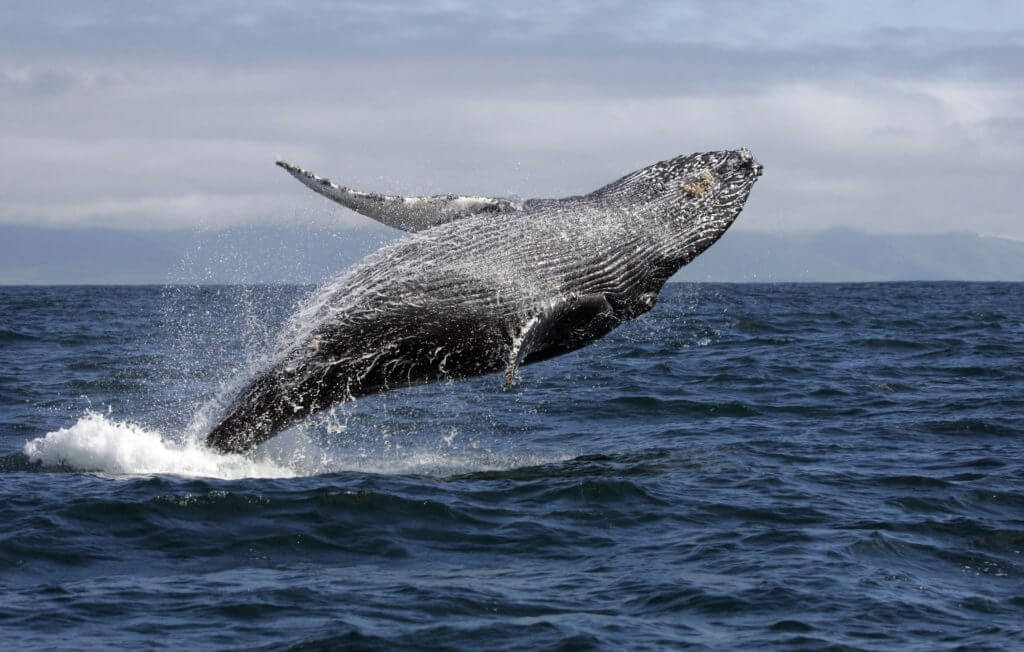Cabo San Lucas Fishing Charters offers many different ways to experience whale watching while at sea. The season for whale watching starts in December and continues through April. Whales are currently migrating over 6000 miles to the Cabo San Lucas area to have their young. One of the best places to observe the whales in the world is Cabo San Lucas. The whales love the warm shallow waters of the Sea of Cortez and the Pacific surrounding Cabo. These gentle giants are amazing to observe, breeching in the beautiful blue waters around the Baja Peninsula. From the shore or from any condo/hotel balcony facing the sea you can take in their blowing of air, jumping up and gracefully gliding across the waters. Or if you want a closer view then look into whale-watching tours or fishing charters.
I’ve read that there is no sanctioned seasons in Cabo San Lucas for whale watching as there is in other areas of Mexico. Along with seeing gray, humpback and blue whales you are likely to see dolphins, sea turtles, orcas, manta rays, mobula rays, California sea lions and a variety of sharks.
Watching whales is an activity that is regulated, which really means that a flag needs to be displayed on your deep sea fishing boat or charter. One regulation is while approaching from the tail end of the whale, the distance must be at least 60 to 80 feet away. Charter boats need to stay at 4 km or less. Captains must also watch their clocks, since the observation time cannot exceed 30 minutes for each whale.
Several tours reported that whales have been very active, at times jumping high with gymnastic ability and singing. As it turns out, male and female whales vocalize or sing, but only the males sing with a long and very loud scale, sometimes lasting 20 minutes. Males are often singing very loudly during the mating season, with the purpose of aiding to the mate selection!
Gray whales are a very interesting breed of whale. They travel approximately ten to twelve thousand miles round trip each year from their feeding grounds in the Artic Sea for their calving in the warm Mexican waters. They have been seen this year in bigger numbers than in years past. They seem to like the waters around Cabo San Lucas with lots of time to relax and mixing with other sea creatures. The mothers and their calves have been seen in the lagoons just north of Cabo San Lucas.
Gray whales are very lively, curious and enjoy swimming in close to boats. They are known for the spy hopping and breaching. Recently seen from the boats, they have been surfing in shallow waters. And for this reason they are the most watched of the whales in the area.

Lately boats have seen the baby humpback whales parading in with their proud mothers. Most were born in January and many in pairs! The babies usually weigh in around 500 to 600kg and are about 4 meters long. When they leave Cabo, they are about twelve feet long! The babies are a light soft gray color, but their skin will get darker with sun exposure. Sightings are often of the baby’s breaching while following their mothers, then a tail slap or two. So exciting to see, this beautiful show of nature. They are growing fast with each new day and getting stronger, nursing from their mom and growing about 72 pounds each day. Humpback whales are said to be the most acrobatic of all whales and the pectoral fin of an adult Humpback whale can be as long as 15 feet!
Blue whales are also enjoying the Sea of Cortez and the Pacific Ocean surrounding Cabo San Lucas. What I didn’t know was that blue whales are one of the largest species to have existed on earth. A grown blue whale can reach 100 feet in length and weigh in at 190 tons. Figures show that their tongues weigh as much as an elephant! The blue whales are the third most common of the whales in the Cabo area. Blue whales have good lungs, and have deep voices that travel long distances. With this attribute, they can stay in contact with other blue whales a thousand kilometers away and they are considered the loudest animals on our planet!
The blue whale can be seen from a distance because of the height of their powerful blows, approximately 12 meters. They are slow swimmers unless they are being followed, which then can travel up to 30 miles an hour.

The female blue whale will give birth on average every two to three years and their babies are weaned at 6 to 7 months. The young whales will reach maturity at 8 to 9 years old.
One cool characteristic concerning whales is that almost every species has unique shaped spouts that experienced whale watchers can identify. Humpback whales can move their eyes separately of the other eye! Humpbacks are known to dive at depths of 700 feet and swim speeds of 25 k/ph in spurts when they fear danger.
Whale watching excursions in Cabo San Lucas is big business. You don’t need to go out very far for close up viewing. You might check into a fishing excursion that would also offer whale watching. After all, both would be nice while you are already out reeling in a big catch. Blue Sky Cabo has excellent choices for deep sea fishing charters. Four beautiful choices of yachts, select your time of day, make the reservation and have the time of your life. One of our experienced captains and crewmembers are sure to make it a luxurious trip. Take the family and a camera and have the time of our your life! There’s nothing that will take your breath away faster than seeing a massive 20-ton whale jumping for the sky, singing and flopping in the beautiful waters of Cabo San Lucas.
Written By,
CBHINE
Is it convenient for you? Have a question? Contact Us









